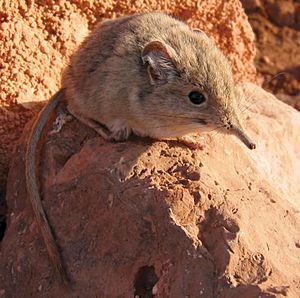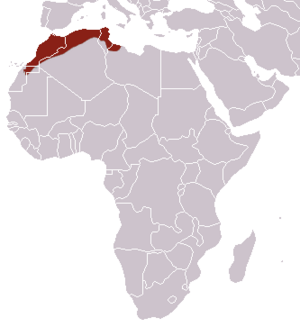North African elephant shrew facts for kids
Quick facts for kids North African elephant shrew |
|
|---|---|
 |
|
| Conservation status | |
| Scientific classification | |
| Genus: |
Petrosaltator
|
| Species: |
rozeti
|
 |
|
| North African elephant shrew range | |
| Synonyms | |
|
|
The North African elephant shrew (Petrosaltator rozeti), also called the North African sengi, is a small, furry mammal. It looks a bit like a mouse but is actually related to elephants! This unique animal lives in parts of Algeria, Libya, Morocco, and Tunisia. It's the only animal in its group (called afrotherians) left in that area. Scientists used to call it Elephantulus rozeti, but new studies in 2016 showed it needed its own special group, Petrosaltator.
Contents
Discovering the North African Elephant Shrew
The North African elephant shrew is a very interesting creature. It might remind you of a small rodent, but it's not one. It has a tiny body, big ears, and a long tail. This sengi is very light, weighing about 50 grams. That's like a small apple!
Its body can be from 24 to 38.5 centimeters long. About half of that length, 13 to 16 centimeters, is its tail. The fur on its back can be yellowish-brown or a pale sandy-pink. Its belly fur is white.
Unique Features of the Sengi
One of the most special things about the North African elephant shrew is its long, flexible snout. It looks a bit like a tiny elephant trunk! The sengi can move this snout all around. Its nostrils are at the very tip. Long, sensitive whiskers grow at the base of its snout. These whiskers help it feel its way around.
Its back legs are longer than its front legs. This helps the sengi run and jump very well. North African elephant shrews also have special glands under their tail. They use these glands to mark their territory. This tells other sengis where their space is. An adult sengi has 42 teeth.
Where the North African Sengi Lives
The North African elephant shrew lives in northwestern Africa. You can find it from the northern Western Sahara to western Libya.
Natural Homes of the Sengi
This animal's natural homes are places with Mediterranean-type shrubby vegetation. This means areas with lots of bushes and small trees. It also lives in deserts.
Life Cycle and Reproduction
The North African sengi typically has babies twice a year. Each time, a mother sengi usually gives birth to 1 to 4 young.


